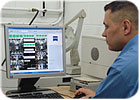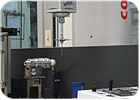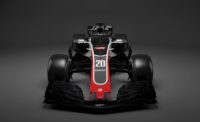
Instructions and images are added to programs with Calypso metrology software. Source: Carl Zeiss Industrial Metrology
As end customers demand more efficient vehicles, automobile producers also require more adept parts from engine component manufacturers. Camcraft Inc. (Hanover Park, IL) knows this first hand and has been relying on coordinate measuring machines (CMMs) from Carl Zeiss (Maple Grove, MN) to drive it to better customer satisfaction.
Camcraft specializes in hydraulic and flow components used in the automotive and off-road vehicle markets. With a manufacturing facility of more than 112,000-square-feet and state-of-the-art equipment, including Hydromat computer numerical control (CNC) machines, Schütte and Euroturn multispindle automatic screw machines, CNC in-feed, cylindrical and ID grinders, micron bore finishing equipment as well as CMMs and vision systems, the company is well equipped to handle orders of varying size and complexity.
Back in 2002, when Camcraft noticed its customers’ target tolerances for parts getting tighter, it realized it needed more precise and efficient quality inspection equipment. In addition, it noticed CMMs were becoming more prevalent in its industry and it wanted to be current with the latest technologies. Its measurement equipment at that time included v-blocks, concentricity gages, dial bore indicators, hand gages and calipers, which could take hours to measure a part and produced varied results from operator to operator. It wanted an inspection machine that could offer standardized inspection programs that various operators could use to measure parts easily and efficiently with consistent and accurate results.
After reviewing its customers’ needs and researching different CMM systems, Camcraft decided that a Zeiss CMM was the best product for its needs. In 2002 it purchased a Contura 7/10/6 because the measuring volume was the right size for its parts, it could reach their targeted geometric dimensioning and tolerancing (GD&T) tolerances of two ten thousandths of an inch and tighter, and they liked the machine’s features and versatility.
Camcraft chose the Vast XT sensor for its fast scanning speed to gather more data points to get better information, and its integrated sensor change rack provides it with versatility for maximum reproducibility without recalibration. The Calypso metrology software is easy to use and allows Camcraft to standardize programs for use by multiple operators.
After its success with the first Contura, Camcraft purchased another and two Contura G2s in the following three years. In addition to these CMMs, it also purchased two Rondcom and two Surfcom systems from Carl Zeiss for surface and form measurements.

A Contura measures intake/exhaust end pieces used on overhead camshafts for V8 engines. Source: Carl Zeiss Industrial Metrology
Inside the Lab
Camcraft has four temperature-controlled inspection labs on their production floor. Each lab is equipped with a Contura and either a Rondcom or a Surfcom. One lab is dedicated to incoming and outgoing quality inspection, the next is dedicated to custom parts for a few specific customers and the remaining two labs are used for standard part inspection. Many parts going out to a third party for processes, such as heat treatment or thermal deburring, need to have their measurements verified with a CMM before and after these processes.Typical parts for Camcraft are aluminum or steel, about 1-inch long and a half an inch in diameter, but it also measures parts that are about 50 times larger such as the intake/exhaust end pieces used on overhead camshafts for V8 engines; this is one example of the CMM’s versatility to measure different part sizes.
A typical part is first blanked out, then secondary operations are performed such as cross holes or slots, some parts could then be sent out for heat treatment by a third party, and finally precision bore sizing and grinding. Operators bring their parts into the labs at the required production stages for quality inspection on a Zeiss machine. Approximately 50 different parts per CMM are measured multiple times per shift.
The ease of use and the ability to standardize measurement programs with Calypso software have been great benefits for Camcraft. “Very little training is required for our operators to use these programs,” states Mike Lee, quality technician-programmable metrology at Camcraft. “This is important because new employees are often measuring on these systems within their first week. Our CMM training procedure consists of talking them through the process, walking them through the first few measurements and then they are ready to measure with our standardized programs.” The ability to add images and instructions to different stages of inspection runs, coupled with QC-Calc SPC to chart and report measurement data, has given Camcraft even more confidence to trust their results.
Reduced inspection times and improved accuracy have been the most significant quantifiable results since purchasing the CMMs. Previous inspection methods such as calipers and hand gages were manual and could take hours to measure a part that could be measured on the Contura in five minutes. Target tolerance capability went from + two thousandths of an inch before the CMMs down to + two ten thousandths of an inch and tighter.
“The surface and form measurement machines from Carl Zeiss have been a lifesaver for our circular and cylindrical measurements,” remarks Lee. “Our Rondcom 60A is an exacting machine with target tolerances of 0.00004 inch cylindricity.”
The Rondcom 60A has a Z axis measuring height of 500 millimeters and a maximum load of 60 kilograms. Their Surfcom 5000DX is used for contour and surface measurements in their inspection lab that is dedicated to special customer projects and high-end applications. This DX version of Surfcom features a wide-range laser interferometer probe with an integrated air isolation system and ergonomic console cabinet.
For Camcraft, the best factors of having Carl Zeiss systems are confidence in accuracy, flexibility and reliability. “The Contura can switch from measuring a square part to a round part without requiring a probe change. You can customize probe sets and take a lot of the thought out of programming,” says Lee. “The reliability of all the machines and the service really make Carl Zeiss stand out in our eyes. With the help of applications support and the regional service technicians, we can quickly get assistance with any programming questions or calibrations.
“Of course having the capability of saving time and money in your production processes is a huge achievement, but being able to be a resource for your customers who are considering CMM investment is very gratifying and helps us build closer relationships,” states Lee. “We’re both working together with a common goal of strengthening our workplace for everyone. The knowledge we have gained from our experience with Zeiss technology has allowed us to be measurement consultants for our customers which is a key to our success with customer satisfaction.”
Carl Zeiss Industrial Metrology
(800) 327-9735
www.zeiss.com/metrology
Benefits
Previous manual inspection methods such as calipers and hand gages could take hours to measure a part; those parts can now be measured in 5 minutes on the Contura.Target tolerance capability went from ± two thousandths of an inch before the CMMs down to ± two ten thousandths of an inch and tighter.
For Camcraft, the best factors of having Carl Zeiss systems are confidence in accuracy, flexibility and reliability.
